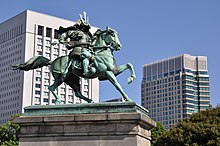Kusunoki Masashige


Kusunoki Masashige (楠木 正成, 1294 - July 4, 1336) was a 14th century samurai who fought for Emperor Go-Daigo in his attempt to wrest rulership of Japan away from the Kamakura shogunate and is remembered as the ideal of samurai loyalty.
Tactician
A brilliant tactician and strategist, Kusunoki's cunning defense of two key Loyalist fortresses at Akasaka and Chihaya helped allow Go-Daigo to briefly return to power. However, one of the loyalist generals, Ashikaga Takauji, betrayed Go-Daigo and led an army against Kusunoki and the remaining loyalists. Kusunoki suggested to the Emperor that they take refuge on sacred Mount Hiei and allow Takauji to take Kyoto, only to swoop down from the mountain, and with the help of the monks of Mount Hiei, trap Takauji in the city and destroy him.
Disaster
Go-Daigo was unwilling to leave the capital however, and insisted that Kusunoki meet Takauji's superior forces in the field in a pitched battle. Kusunoki, in what would later be viewed as the ultimate act of samurai loyalty, obediently accepted his Emperor's foolish command, left his death poem with his young son Masatsura[1] and knowingly marched his army into almost certain death. The battle, which took place at Minatogawa in modern-day Chūō-ku, Kobe, was a tactical disaster. Kusunoki, his army completely surrounded, down to only 73 of the original 700 horsemen, committed suicide along with his brother Masasue, 11 close clan members, and 60 others. According to legend, his brother's last words were Shichisei Hōkoku! (七生報國; "Would that I had seven lives to give for my country!") and Kusunoki Masashige agreed. There are two accounts of arguments that Kusunoki Masashige made to emperor Go-Daigo. One was that they regroup and attack from two sides, the other was that they bring back general Takauji to their side thus balancing the scales. Both arguments were ignored.
Legacy
His son, Masatsura, served the emperor's successor, the 12-year-old Go-Murukami, in a relationship of reciprocal trust and devotion mirroring the figure of his father Kusunoki and keeping the flame of loyalist resistance alive.[2] Masatsura died alongside his brother Masatoki and cousin Wada Takahide in a battle that saw the end of the Kusunoki clan and there followed a less-than-ideal scramble for power and gain among the Courts.[2]
Kusunoki Masashige's successful defense of Chihaya castle is believed to have helped turn the tide against the Kamakura bakufu/shogunate (military rule and the first shogunate). Partly because he held out so long in his castle, Ashikaga Takauji revolted and came to the aid of the emperor, and thus ended the Kamakura bakufu. However, Ashikaga Takauji quickly learned that he did not like following the emperor's commands, and revolted again to establish his own Ashikaga bakufu (the second, middle shogunate). He was able to establish his own shogunate after defeating Kusunoki Masashige and the commander in chief Yoshisada in the final battle. Kusunoki Masashige tried to intervene and bring Ashikaga Takauji back to the emperor's side, but the emperor rejected this plan.
Legend
After the full-scale introduction of Neo-Confucianism as a state philosophy by the Tokugawa Shogunate, Kusunoki Masashige, once-called a traitor by the Northern Court, was resurrected with Emperor Go-Daigo as a precursor of Sinocentric absolutists, based upon the Neo-Confucian theories. During the Edo period, scholars and samurai who were influenced by the Neo-Confucian theories created the legend of Kusunoki and enshrined him as a patriotic hero, called Nankō (楠公) or Dai-Nankō (大楠公), who epitomized loyalty, courage, and devotion to the Emperor. Kusunoki later became a patron saint of sorts to the World War II kamikaze, who saw themselves as his spiritual heirs in sacrificing their lives for the Emperor.
References
External links
Stephen R. Turnbull, The Samurai: A Military History, Routledge.[2]
